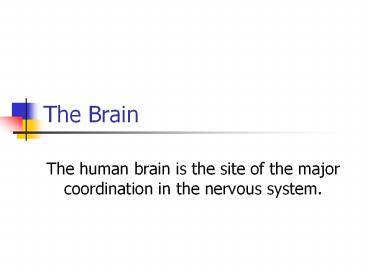The Brain - PowerPoint PPT Presentation
1 / 23
Title:
The Brain
Description:
The Brain The human brain is the site of the major coordination in the nervous system. The Brain Areas of the brain The brain is composed of Cerebral Hemispheres ... – PowerPoint PPT presentation
Number of Views:104
Avg rating:3.0/5.0
Title: The Brain
1
The Brain
- The human brain is the site of the major
coordination in the nervous system.
2
The Brain
Cerebrum
Hypothalamus
Cerebellum
Pituitary gland
Medulla
3
Areas of the brain
- The brain is composed of Cerebral Hemispheres,
Cerebellum and Medulla
4
medulla
- Controls autonomic activities including heart
rate, and ventilation rate - Impulse transmitted from medulla via sympathetic
or parasympathetic branch of automatic nervous
system
Medulla
Cerebral Hemispheres
Cerebellum
5
cerebellum
- Co-ordination of body movement, balance and
posture
Cerebral Hemispheres
Cerebellum
6
cerebrum/cerebral hemispheres
- Highly Folded and so has a large SA.
- Patients with injuries to specific parts of the
brain can be studied to see how their functions
are altered.
Cerebral Hemispheres
Cerebellum
Medulla
7
cerebrum/cerebral hemispheres
- Different parts of the brain can be stimulated
electrically to see which muscles in the body
respond - Conversely different parts of the body can be
stimulated to see which parts of the brain show
electrical activity. - More recently MRI (magnetic resonance imaging)
has been used in brain study
8
(No Transcript)
9
Areas of the cerebrum
10
The Areas can be split into 3 groups
- Sensory Areas
- Motor Areas
- Association Areas
11
Motor
Association
Sensory
Sensory area for impulses from eyes
12
cerebrum/cerebral hemispheres
- Sensory areas of the cerebral hemispheres receive
impulses from sense organs and transmit them to
the association areas - The association areas of the cerebral hemispheres
receive impulses - interpret them in the light
of similar past experiences and transmit impulses
to motor areas - The motor areas transmit impulses to the
effectors - The size of the sensory and motor areas is
related to the number of receptors in that area - The left and right cerebral hemispheres control
the opposite sides of the body
13
Mapping of the sensory motor areas to the body
14
Sensory Motor Maps
- The maps show that regions of the body with many
sensory (or motor) neurones have corresponding
large areas of the cerebrum linked to them. - So for example the lips occupy a larger region of
the sensory cortex than the shoulder, because
there are more sensory neurones in the lips.
15
Association Areas
- Are used to compare sensory input with previous
experiences, and make decisions - These areas are involved in speech, understanding
and memory retrieval - The frontal lobes are large in humans and it is
thought that they responsible for higher
functions like abstract thought, personality
emotion.
16
Speech
- The left side of the brain
- Patients with speech problems gave 1st clues
about how the brain controls language - 1981 Dr Paul Broca described a patient who could
only say the word tan. - When the patient died Broca examined the brain
and found damage to the left cerebral hemisphere - This part of the brain is now know as Brocas area
17
Brocas Area
Brocas area
18
Wernickes Area
- In 1967 Karl Wernicke noticed damage to another
region of the cortex. - Werniches area is connected to Brocas area by a
bundle of nerve fibres. - If this was damaged the patient can understand
language but cannot repeat words. - So Werniches area is concerned with
understanding language. Brocas area is concerned
with controlling the muscles that produce speech
19
Wernickes Area
Wernickes area
20
Visual Processing
- The visual sensory area is at the back of the
brain receives sensory input from the optic
nerves - The 2 hemispheres see slightly different images
from the opposite of the visual field, and
differences can be used to judge distance
21
Optic Chiasma
22
Summary
- Sensory areas receive input from receptors
- Motor areas Origin of impulses which bring
about voluntary movements - These receive/transmit impulses from the opposite
side of the body - Association areas interpret sensory information
in the light of experience
23
A close shave































